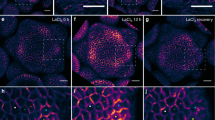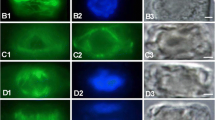Summary
The effects of red and blue light on the orientation of cortical microtubules (MTs) underneath the outer epidermal wall of maize (Zea mays L.) coleoptiles were investigated with immunofluorescent techniques. The epidermal cells of dark-grown coleoptiles demonstrated an irregular pattern of regions of parallel MTs with a random distribution of orientations. This pattern could be changed into a uniformly transverse MT alignment with respect to the long cell axis by 1 h of irradiation with red light. This response was transient as the MTs spontaneously shifted into a longitudinal orientation after 1–2 h of continued irradiation. Induction/reversion experiments with short red and far-red light pulses demonstrated the involvement of phytochrome in this response. In contrast to red light, irradiation with blue light induced a stable longitudinal MT alignment which was established within 10 min. The blue-light response could not be affected by subsequent irradiations with red or far-red light indicating the involvement of a separate blue-light photoreceptor which antagonizes the effect of phytochrome. In mixed light treatments with red and blue light, the blue-light photoreceptor always dominated over phytochrome which exhibited an apparently less stable influence on MT orientation. Long-term irradiations with red or blue light up to 6 h did not reveal any rhythmic changes of MT orientation that could be related to the rhythmicity of helicoidal cell-wall structure. Subapical segments isolated from dark-grown coleoptiles maintained a longitudinal MT arrangement even in red light indicating that the responsiveness to phytochrome was lost upon isolation. Conversely auxin induced a transverse MT arrangement in isolated segments even in blue light, indicating that the responsiveness to blue-light photoreceptor was eliminated by the hormone. These complex interactions are discussed in the context of current hypotheses on the functional significance of MT reorientations for cell development.
Similar content being viewed by others
Abbreviations
- MT:
-
cortical microtubule
- Pr, Pfr :
-
red and far-red absorbing form of phytochrome
References
Bergfeld R, Speth V, Schopfer P (1988) Reorientation of microfibrils and microtubules at the outer epidermal wall of maize coleoptiles during auxin-mediated growth. Bot Acta 101: 133–138
Drumm-Herrel H, Mohr H (1991) Involvement of phytochrome in light control of stem elongation in cucumber (Cucumis sativus L.) seedlings. Photochem Photobiol 53: 539–544
Edelmann H (1989) Untersuchungen zur Zellwandsynthese während des Auxin-induzierten Zellstreckungswachstums von Maiskoleoptilen (Zea mays L.). Ph.D. Thesis University of Freiburg, Freiburg, Federal Republic of Germany
Giddings TH, Staehelin LA (1991) Microtubule-mediated control of microfibril deposition: a re-examination of the hypothesis. In: Lloyd CW (ed) The cytoskeletal basis of plant growth and form. Academic Press, London, pp 85–99
Hohl M, Schopfer P (1992) Cell-wall tension of the inner tissue of the maize coleoptile and its potential contribution to auxin-mediated organ growth. Planta 188: 340–344
Hush JM, Hawes CR, Overall RL (1990) Interphase microtubule re-orientation predicts a new cell polarity in wounded pea roots. J Cell Sci 96: 47–61
—, Overall RL (1991) Electrical and mechanical fields orient cortical microtubules in higher plant tissues. Cell Biol Int Rep 15: 551–560
Ishida K, Katsumi M (1992) Effects of gibberellin and abscisic acid on the cortical microtubule orientation in hypocotyl cells of light-grown cucumber seedlings. Int J Plant Sci 153: 155–163
Iwata K, Hogetsu T (1989) The effects of light irradiation on the orientation of microtubules in seedlings ofAvena sativa L. andPisum sativum L. Plant Cell Physiol 30: 1011–1016
Kutschera U, Schopfer P (1985) Evidence against the acid-growth theory of auxin action. Planta 163: 483–493
Laskowski MJ (1990) Microtubule orientation in pea stem cells: a change in orientation follows the initiation of growth rate decline. Planta 181: 44–52
Mohr H, Schoser G (1960) Eine mit Xenonbögen ausgerüstete Interferenzfilter-Monochromatoranlage für kurzwellige sichtbare und langwellige ultraviolette Strahlung. Planta 55: 143–152
Nick P, Bergfeld R, Schäfer E, Schopfer P (1990) Unilateral reorientation of microtubules at the outer epidermal wall during photo- and gravitropic curvature of maize coleoptiles and sunflower hypocotyls. Planta 181: 162–168
—, Furuya M, Schäfer E (1991) Do microtubules control growth in tropism? Experiments with maize coleoptiles. Plant Cell Physiol 32: 999–1006
—, Schäfer E, Furuya M (1992) Auxin redistribution during first positive phototropism in corn coleoptiles. Microtubule reorientation and the Cholodny-Went theory. Plant Physiol 99: 1302–1308
Roberts IN, Lloyd CW, Roberts K (1985) Ethylene-induced microtubule reorientations: mediation be helical arrays. Planta 164: 439–447
Sakiyama M, Shibaoka H (1990) Effects of abscisic acid on the orientation and cold stability of cortical microtubules in epicotyl cells of the dwarf pea. Protoplasma 157: 165–171
Sakoda M, Hasegawa K, Ishizuka K (1992) Mode of action of natural growth inhibitors in radish hypocotyl elongation — influence of raphanusanin on auxin-mediated microtubule orientation. Physiol Plant 84: 509–513
Satiat-Jeunemaitre B (1984) Experimental modifications of the twisting and rhythmic pattern in the cell walls of maize coleoptile. Biol Cell 51: 373–380
Schäfer E, Lassig T-M, Schopfer P (1982) Phytochrome-controlled extension growth ofAvena sativa L. seedlings. II. Fluence rate response relationships and action spectra of mesocotyl and coleoptile responses. Planta 154: 231–240
Seagull RW (1992) The hormonal regulation of cell elongation through changes in microtubule orientation. Int J Plant Sci 153: iii-iv
Shibaoka H (1974) Involvement of wall microtubules in gibberellin promotion and kinetin inhibition of stem elongation. Plant Cell Physiol 15: 255–263
— (1991) Microtubules and the regulation of cell morphogenesis by plant hormones. In: Lloyd CW (ed) The cytoskeletal basis of plant growth and form. Academic Press, London, pp 159–168
Vian B, Roland J-C (1987) The helicoidal cell wall as a time register. New Phytol 105: 345–357
Williamson RE (1990) Alignment of cortical microtubules by anisotropic wall stresses. Aust J Plant Physiol 17: 601–613
— (1991) Orientation of cortical microtubules in interphase plant cells. Int Rev Cytol 129: 135–206
Author information
Authors and Affiliations
Rights and permissions
About this article
Cite this article
Zandomeni, K., Schopfer, P. Reorientation of microtubules at the outer epidermal wall of maize coleoptiles by phytochrome, blue-light photoreceptor, and auxin. Protoplasma 173, 103–112 (1993). https://doi.org/10.1007/BF01378999
Received:
Accepted:
Issue Date:
DOI: https://doi.org/10.1007/BF01378999




